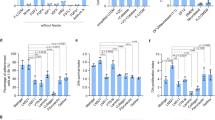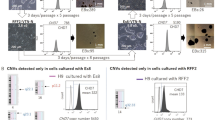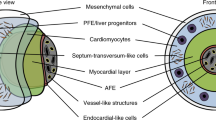Abstract
The endodermal germ layer gives rise to respiratory epithelium, hepatocytes, pancreatic cells and intestinal lineages, among other cell types. These lineages can be differentiated from human pluripotent stem cells (hPSCs) via a common definitive endoderm (DE) intermediate that is characterized by the co-expression of the cell surface markers CXCR4, c-KIT and EPCAM and the transcription factors SOX17 and FOXA2. Here we provide a detailed protocol for mass production of DE from hPSCs in scalable and easy-to-handle suspension culture using a rotating Erlenmeyer flask or a sophisticated, fully controllable, 150-ml stirred tank bioreactor. This protocol uses two different media formulations that are chemically defined and xeno free and therefore good manufacturing practice ready. Our protocol allows for efficient hPSC-derived DE specification in multicellular aggregates within 3 days and generates up to 1 × 108 DE cells with >92% purity in one differentiation batch when using the bioreactor. The hPSC-derived DE cells that are generated can be cryopreserved for later downstream differentiation into various endodermal lineages. This protocol should facilitate the flexible production of mature DE derivatives for physiologically relevant disease models, high-throughput drug screening, toxicology testing and cellular therapies.
This is a preview of subscription content, access via your institution
Access options
Access Nature and 54 other Nature Portfolio journals
Get Nature+, our best-value online-access subscription
$29.99 / 30 days
cancel any time
Subscribe to this journal
Receive 12 print issues and online access
$259.00 per year
only $21.58 per issue
Buy this article
- Purchase on Springer Link
- Instant access to full article PDF
Prices may be subject to local taxes which are calculated during checkout




Similar content being viewed by others
Data availability
Data regarding cell viability are included as Supplementary Data. The other data presented here were previously published and are available in the original publication13.
References
Dianat, N., Steichen, C., Vallier, L., Weber, A. & Dubart-Kupperschmitt, A. Human pluripotent stem cells for modelling human liver diseases and cell therapy. Curr. Gene Ther. 13, 120–132 (2013).
Hohwieler, M. et al. Human pluripotent stem cell-derived acinar/ductal organoids generate human pancreas upon orthotopic transplantation and allow disease modelling. Gut 66, 473–486 (2017).
Mithal, A. et al. Generation of mesenchyme free intestinal organoids from human induced pluripotent stem cells. Nat. Commun. 11, 215 (2020).
Snoeck, H. W. Modeling human lung development and disease using pluripotent stem cells. Development 142, 13–16 (2015).
Carpentier, A. et al. Hepatic differentiation of human pluripotent stem cells in miniaturized format suitable for high-throughput screen. Stem Cell Res. 16, 640–650 (2016).
Sirenko, O. et al. Phenotypic characterization of toxic compound effects on liver spheroids derived from iPSC using confocal imaging and three-dimensional image analysis. Assay Drug Dev. Technol. 14, 381–394 (2016).
Yiangou, L., Ross, A. D. B., Goh, K. J. & Vallier, L. Human pluripotent stem cell-derived endoderm for modeling development and clinical applications. Cell Stem Cell 22, 485–499 (2018).
Zuba-Surma, E. K., Wojakowski, W., Madeja, Z. & Ratajczak, M. Z. Stem cells as a novel tool for drug screening and treatment of degenerative diseases. Curr. Pharm. Des. 18, 2644–2656 (2012).
Elitt, M. S., Barbar, L. & Tesar, P. J. Drug screening for human genetic diseases using iPSC models. Hum. Mol. Genet. 27, R89–R98 (2018).
Yabe, S. G. et al. Induction of functional islet-like cells from human iPS cells by suspension culture. Regen. Ther. 10, 69–76 (2019).
Chen, S. et al. Hepatic spheroids derived from human induced pluripotent stem cells in bio-artificial liver rescue porcine acute liver failure. Cell Res. 30, 95–97 (2019).
Sahabian et al. Chemically-defined, xeno-free, scalable production of hPSC-derived definitive endoderm aggregates with multi-lineage differentiation potential. Cells 8, 1571 (2019).
Watanabe, K. et al. A ROCK inhibitor permits survival of dissociated human embryonic stem cells. Nat. Biotechnol. 25, 681–686 (2007).
Kuo, H. H. et al. Negligible-cost and weekend-free chemically defined human iPSC culture. Stem Cell Rep. 14, 256–270 (2020).
Lian, X. et al. Directed cardiomyocyte differentiation from human pluripotent stem cells by modulating Wnt/beta-catenin signaling under fully defined conditions. Nat. Protoc. 8, 162–175 (2013).
Hannan, N. R., Segeritz, C. P., Touboul, T. & Vallier, L. Production of hepatocyte-like cells from human pluripotent stem cells. Nat. Protoc. 8, 430–437 (2013).
Lee, G., Chambers, S. M., Tomishima, M. J. & Studer, L. Derivation of neural crest cells from human pluripotent stem cells. Nat. Protoc. 5, 688–701 (2010).
Gerecht-Nir, S., Cohen, S. & Itskovitz-Eldor, J. Bioreactor cultivation enhances the efficiency of human embryoid body (hEB) formation and differentiation. Biotechnol. Bioeng. 86, 493–502 (2004).
Assady, S. et al. Insulin production by human embryonic stem cells. Diabetes 50, 1691–1697 (2001).
Kempf, H., Kropp, C., Olmer, R., Martin, U. & Zweigerdt, R. Cardiac differentiation of human pluripotent stem cells in scalable suspension culture. Nat. Protoc. 10, 1345–1361 (2015).
Olmer, R. et al. Suspension culture of human pluripotent stem cells in controlled, stirred bioreactors. Tissue Eng. Part C Methods 18, 772–784 (2012).
Amit, M. et al. Suspension culture of undifferentiated human embryonic and induced pluripotent stem cells. Stem Cell Rev. Rep. 6, 248–259 (2010).
Olmer, R. et al. Long term expansion of undifferentiated human iPS and ES cells in suspension culture using a defined medium. Stem Cell Res. 5, 51–64 (2010).
Singh, H., Mok, P., Balakrishnan, T., Rahmat, S. N. & Zweigerdt, R. Up-scaling single cell-inoculated suspension culture of human embryonic stem cells. Stem Cell Res. 4, 165–179 (2010).
Zweigerdt, R., Olmer, R., Singh, H., Haverich, A. & Martin, U. Scalable expansion of human pluripotent stem cells in suspension culture. Nat. Protoc. 6, 689–700 (2011).
Kropp, C. et al. Impact of feeding strategies on the scalable expansion of human pluripotent stem cells in single-use stirred tank bioreactors. Stem Cells Transl. Med. 5, 1289–1301 (2016).
Kempf, H. et al. Bulk cell density and Wnt/TGFβ signalling regulate mesendodermal patterning of human pluripotent stem cells. Nat. Commun. 7, 13602 (2016).
Ackermann, M. et al. Bioreactor-based mass production of human iPSC-derived macrophages enables immunotherapies against bacterial airway infections. Nat. Commun. 9, 5088 (2018).
Farzaneh, Z., Najarasl, M., Abbasalizadeh, S., Vosough, M. & Baharvand, H. Developing a cost-effective and scalable production of human hepatic competent endoderm from size-controlled pluripotent stem cell aggregates. Stem Cells Dev. 27, 262–274 (2018).
Olmer, R. et al. Differentiation of human pluripotent stem cells into functional endothelial cells in scalable suspension culture. Stem Cell Reports 10, 1657–1672 (2018).
Palakkan, A. A., Nanda, J. & Ross, J. A. Human induced pluripotent stem cell-derived definitive endoderm bulk culture and hepatic differentiation. Methods Mol. Biol. 1994, 41–53 (2019).
Sui, L., Leibel, R. L. & Egli, D. Pancreatic beta cell differentiation from human pluripotent stem cells. Curr. Protoc. Hum. Genet. 99, e68 (2018).
Wong, A. P. et al. Efficient generation of functional CFTR-expressing airway epithelial cells from human pluripotent stem cells. Nat. Protoc. 10, 363–381 (2015).
Hawkins, F. et al. Prospective isolation of NKX2-1-expressing human lung progenitors derived from pluripotent stem cells. J. Clin. Investig. 127, 2277–2294 (2017).
Dekkers, J. F. et al. A functional CFTR assay using primary cystic fibrosis intestinal organoids. Nat. Med. 19, 939–945 (2013).
Merkert, S. et al. High-throughput screening for modulators of CFTR activity based on genetically engineered cystic fibrosis disease-specific iPSCs. Stem Cell Rep. 12, 1389–1403 (2019).
Nie, Y. Z. et al. Recapitulation of hepatitis B virus-host interactions in liver organoids from human induced pluripotent stem cells. EBioMedicine 35, 114–123 (2018).
Porotto, M. et al. Authentic modeling of human respiratory virus infection in human pluripotent stem cell-derived lung organoids. mBio 10, 1–13 (2019).
Iansante, V., Chandrashekran, A. & Dhawan, A. Cell-based liver therapies: past, present and future. Philos. Trans. R. Soc. Lond. B Biol. Sci. 373, 1750 (2018).
McLean, A. B. et al. Activin a efficiently specifies definitive endoderm from human embryonic stem cells only when phosphatidylinositol 3-kinase signaling is suppressed. Stem Cells 25, 29–38 (2007).
Diekmann, U. et al. Chemically defined and xenogeneic-free differentiation of human pluripotent stem cells into definitive endoderm in 3D culture. Sci. Rep. 9, 996 (2019).
Yabe, S. G. et al. Definitive endoderm differentiation is promoted in suspension cultured human iPS-derived spheroids more than in adherent cells. Int. J. Dev. Biol. 63, 271–280 (2019).
Abecasis, B. et al. Expansion of 3D human induced pluripotent stem cell aggregates in bioreactors: bioprocess intensification and scaling-up approaches. J. Biotechnol. 246, 81–93 (2017).
Shinohara, M. et al. Endodermal differentiation of human induced pluripotent stem cells using simple dialysis culture system in suspension culture. Regen. Ther. 12, 14–19 (2019).
Lock, L. T. & Tzanakakis, E. S. Expansion and differentiation of human embryonic stem cells to endoderm progeny in a microcarrier stirred-suspension culture. Tissue Eng. Part A 15, 2051–2063 (2009).
Park, Y., Chen, Y., Ordovas, L. & Verfaillie, C. M. Hepatic differentiation of human embryonic stem cells on microcarriers. J. Biotechnol. 174, 39–48 (2014).
Schlegelberger, B. et al. Clinicopathogenetic significance of chromosomal abnormalities in patients with blastic peripheral B-cell lymphoma. Kiel–Wien–Lymphoma Study Group. Blood 94, 3114–3120 (1999).
Drick, N. et al. Generation of a NKX2.1 - p63 double transgenic knock-in reporter cell line from human induced pluripotent stem cells (MHHi006-A-4). Stem Cell Res. 42, 101659 (2020).
Sullivan, S. et al. Quality control guidelines for clinical-grade human induced pluripotent stem cell lines. Regen. Med. 13, 859–866 (2018).
Lavon, N., Zimerman, M. & Itskovitz-Eldor, J. Scalable expansion of pluripotent stem cells. Adv. Biochem. Eng. Biotechnol. 163, 23–37 (2018).
Davis, B. M., Loghin, E. R., Conway, K. R. & Zhang, X. Automated closed-system expansion of pluripotent stem cell aggregates in a rocking-motion bioreactor. SLAS Technol. 23, 364–373 (2018).
Sgodda, M. et al. A scalable approach for the generation of human pluripotent stem cell-derived hepatic organoids with sensitive hepatotoxicity features. Stem Cells Dev. 26, 1490–1504 (2017).
Miller, A. J. et al. Generation of lung organoids from human pluripotent stem cells in vitro. Nat. Protoc. 14, 518–540 (2019).
McCauley, K. B. et al. Efficient derivation of functional human airway epithelium from pluripotent stem cells via temporal regulation of Wnt signaling. Cell Stem Cell 20, 844–857 (2017).
Sart, S., Ma, T. & Li, Y. Cryopreservation of pluripotent stem cell aggregates in defined protein-free formulation. Biotechnol. Prog. 29, 143–153 (2013).
Haase, A., Gohring, G. & Martin, U. Generation of non-transgenic iPS cells from human cord blood CD34+ cells under animal component-free conditions. Stem Cell Res. 21, 71–73 (2017).
Acknowledgements
We thank members of the Zweigerdt group, especially C. Halloin and W. Löbel, for help and suggestions regarding the experimental setup of the bioreactor. We also thank T. Scheper for providing bFGF and A. Kirschning and G. Dräger for providing CHIR99021. Parts of Fig. 1 were created using Servier Medical Art templates, which are licensed under a Creative Commons Attribution 3.0 Unported License. This research was funded by the German Center for Lung Research (DZL, BREATH 82DZL002A1) and Federal State of Lower Saxony R2N (74ZN1574).
Author information
Authors and Affiliations
Contributions
A.S. conceptualized and performed all experiments and analysis. A.S., J.D., R.O. and U.M. wrote the manuscript. R.O. and U.M. conceptualized and supervised the project and provided project administration and funding acquisition. All authors approved the final manuscript.
Corresponding authors
Ethics declarations
Competing interests
The authors declare no competing interests.
Additional information
Peer review information Nature Protocols thanks the anonymous reviewers for their contribution to the peer review of this work.
Publisher’s note Springer Nature remains neutral with regard to jurisdictional claims in published maps and institutional affiliations.
Related links
Key reference using this protocol
Sahabian, A. et al. Cells 8, 1571 (2019): https://doi.org/10.3390/cells8121571
Key data used in this protocol
Sahabian, A. et al. Cells 8, 1571 (2019): https://doi.org/10.3390/cells8121571
Supplementary information
Supplementary Data
Source data for cell viability results are included in the ‘Anticipated Results’ section. Cell viability was assessed by Beckman Coulter Vi-CELL X.
Rights and permissions
About this article
Cite this article
Sahabian, A., Dahlmann, J., Martin, U. et al. Production and cryopreservation of definitive endoderm from human pluripotent stem cells under defined and scalable culture conditions. Nat Protoc 16, 1581–1599 (2021). https://doi.org/10.1038/s41596-020-00470-5
Received:
Accepted:
Published:
Issue Date:
DOI: https://doi.org/10.1038/s41596-020-00470-5
This article is cited by
-
A live-cell image-based machine learning strategy for reducing variability in PSC differentiation systems
Cell Discovery (2023)
-
Efficiently generate functional hepatic cells from human pluripotent stem cells by complete small-molecule strategy
Stem Cell Research & Therapy (2022)
-
Reconstructing the pulmonary niche with stem cells: a lung story
Stem Cell Research & Therapy (2022)
-
Continuous human iPSC-macrophage mass production by suspension culture in stirred tank bioreactors
Nature Protocols (2022)
Comments
By submitting a comment you agree to abide by our Terms and Community Guidelines. If you find something abusive or that does not comply with our terms or guidelines please flag it as inappropriate.



